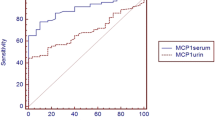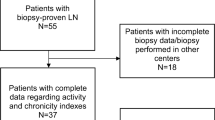Abstract
The infiltration of leukocytes into the glomeruli is a major factor in inflammatory glomerular damage in acute poststreptococcal glomerulonephritis (APSGN). Chemokines participate in leukocyte infiltration. The aim of the present study was to investigate the role of monocyte chemoattractant protein-1 (CCL2/MCP-1) and interleukin-8 (CXL8/IL-8) in APSGN with special emphasis on their role in the clinical course of renal disease. Twenty-one children with APSGN were studied. Serum and urinary CCL2/MCP-1 and CXL8/IL-8 levels were measured by ELISA. The relationships between urinary chemokines and the degree of proteinuria were investigated. Serum and urinary CCL2/MCP-1 levels were significantly higher in the acute phase than in the resolution phase and in controls ( P <0.05). Urinary CCL2/MCP-1 levels in the control group were significantly lower than in both the acute and resolution phases ( P =0.01 and P =0.001, respectively). In the acute phase, urinary CCL2/MCP-1 correlated with the extent of proteinuria ( r =0.58, P =0.006) but not with serum CCL2/MCP-1 levels ( r =0.21, P =0.36). Urinary and serum CXL8/IL-8 levels were significantly elevated in the acute phase compared with the resolution phase and controls ( P <0.05). A consistent increase in urinary CCL2/MCP-1 was found in the acute phase of patients with APSGN, and this correlates with the degree of proteinuria. Our results emphasize the important role of locally produced chemokines in immune-mediated glomerular injury.




Similar content being viewed by others
References
Ruiz P, Soares MF (2003) Acute postinfectious glomerulonephritis: an immune response gone bad? Hum Pathol 34:1–2
Anders HJ, Vielhauer V, Schlöndorff D (2003) Chemokines and chemokine receptors are involved in the resolution or progression of renal disease. Kidney Int 63:401–415
Rovin BH, Yoshimura T, Tan L (1992) Cytokine-induced production of monocyte chemoattractant protein-1 by cultured human mesangial cells. J Immunol 148:2148–2153
Tam FW, Karkar AM, Smith J, Yoshimura T, Steinkasserer A, Kurrle R, Langner K, Rees AJ (1996) Differential expression of macrophage inflammatory protein-2 and monocyte chemoattractant protein-1 in experimental glomerulonephritis. Kidney Int 49:715–721
Cattell V (1994) Macrophages in acute glomerular inflammation. Kidney Int 45:945–952
Rovin BH, Doe N, Tan LC (1996) Monocyte chemoattractant protein-1 levels in patients with glomerular disease. Am J Kidney Dis 27:640–646
Sica A, Wang JM, Colotta F, Dejana E, Mantovani A, Oppenheim JJ, Larsen CG, Zachariae CO, Matsushima K (1990) Monocyte chemotactic and activating factor gene expression induced in endothelial cells by IL-1 and tumor necrosis factor. J Immunol 144:3034–3038
Brown Z, Strieter RM, Chensue SW, Ceska M, Lindley I, Neild GH, Kunkel SL, Westwick J (1991) Cytokine-activated human mesangial cells generate the neutrophil chemoattractant, interleukin-8. Kidney Int 40:86–90
Lloyd CM, Minto AW, Dorf ME, Proudfoot A, Wells TN, Salant DJ, Gutierrez-Ramos JC (1997) RANTES and monocyte chemoattractant protein-1 (MCP-1) play an important role in the inflammatory phase of crescentic nephritis, but only MCP-1 is involved in crescent formation and interstitial fibrosis. J Exp Med 185:1371–1380
Schwarz M, Wahl M, Resch K, Radeke HH (2002) IFNγ induces functional chemokine receptor expression in human mesangial cells. Clin Exp Immunol 128:285–294
Yokoyama H, Wada T, Furuichi K, Segawa C, Shimizu M, Kobayashi K, Su S, Mukaida N, Matsushima K (1998) Urinary levels of chemokines (MCAF/MCP-1, IL-8) reflect distinct disease activities and phases of human IgA nephropathy. J Leukoc Biol 63:493–499
Cu GA, Mezzano S, Bannan JD, Zabriskie JB (1998) Immunohistochemical and serological evidence for the role of streptococcal proteins in acute poststreptococcal glomerulonephritis. Kidney Int 54:819–826
Rincon J, Viera NT, Romero MJ, Mosquera JA (2003) Increased production of chemotactic cytokines and elevated proliferation and expression of intercellular adhesion molecule-1 in rat mesangial cells treated with erythrogenic toxin type B and its precursor isolated from nephritogenic streptococci. Nephrol Dial Transplant 18:1072–1078
Walpen S, Beck KF, Schaefer L, Raslik I, Eberhardt W, Schaefer RM, Pfeilschifter J (2001) Nitric oxide induces MIP-2 transcription in rat renal mesangial cells and in a rat model of glomerulonephritis. FASEB J 15:571–573
Panzer U, Thaiss F, Zahner G, Barth P, Reszka M, Reinking RR, Wolf G, Helmchen U, Stahl RA (2001) Monocyte chemoattractant protein-1 and osteopontin differentially regulate monocytes recruitment in experimental glomerulonephritis. Kidney Int 59:1762–1769
Rovin BH, Rumancik M, Tan L, Dickerson J (1994) Glomerular expression of monocyte chemoattractant protein-1 in experimental and human glomerulonephritis. Lab Invest 71:536–542
Anders HJ, Vielhauer V, Kretzler M, Cohen CD, Segerer S, Luckow B, Weller L, Gröne HJ, Schlöndorff D (2001) Chemokine and chemokine receptor expression during initiation and resolution of immune complex glomerulonephritis. J Am Soc Nephrol 12:919–931
Bird JE, Giancarli MR, Kurihara T, Kowala MC, Valentine MT, Gitlitz PH, Pandya DG, French MH, Durham SK (2000) Increased severity of glomerulonephritis C-C chemokine receptor 2 in knockout mice. Kidney Int 57:129–136
Mezzano S, Burgos ME, Olavarria F, Caorsi I (1997) Immunohistochemical localization of IL-8 and TGF-beta in streptococcal glomerulonephritis. J Am Soc Nephrol 8:234–241
Wada T, Yokoyama H, Tomosugi N, Hisada Y, Ohta S, Naito T, Kobayashi K, Mukaida N, Matsushima K (1994) Detection of urinary interleukin-8 in glomerular diseases. Kidney Int 46:455–460
Heinzelmann M, Mercer-Jones MA, Passmore JC (1999) Neutrophils and renal failure. Am J Kidney Dis 34:384–399
Acknowledgements
The authors are grateful for the support of the Hacettepe University Institute of Child Health. We thank Yucel Bassoy for excellent technical assistance.
Author information
Authors and Affiliations
Corresponding author
Rights and permissions
About this article
Cite this article
Besbas, N., Ozaltin, F., Catal, F. et al. Monocyte chemoattractant protein-1 and interleukin-8 levels in children with acute poststreptococcal glomerulonephritis. Pediatr Nephrol 19, 864–868 (2004). https://doi.org/10.1007/s00467-004-1522-0
Received:
Revised:
Accepted:
Published:
Issue Date:
DOI: https://doi.org/10.1007/s00467-004-1522-0




